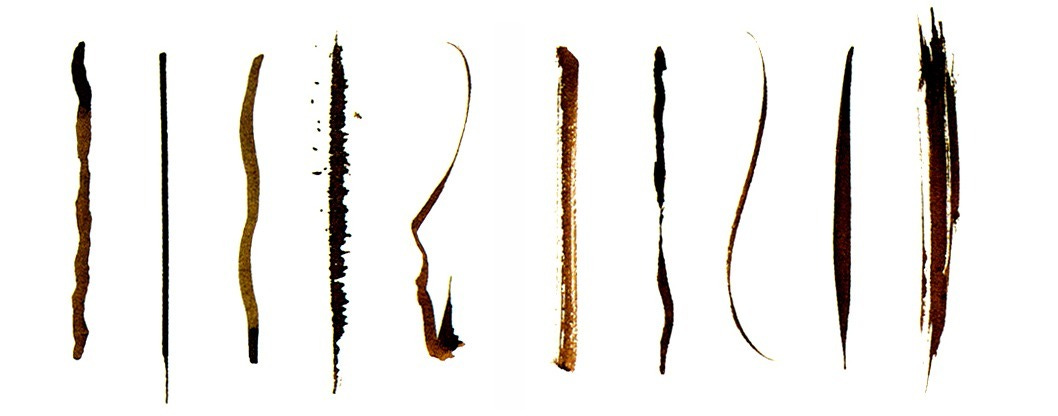Breathe yourself into the line.
Let’s think about line quality. A dot or point has no dimension, but it has location. It’s the beginning of a line. But is it? We’ve heard Paul Klee’s definition of a line as “a dot that went for a walk.” The peripatetic dot fosters an image of wandering, meandering, seeking perhaps, and enjoying the tangible movement and contact with the visible emerging line. A walk is quiet and relatively slow, even at the pace of a power walk. It doesn’t jump, slide, or race. It goes from point A to point B without crying or feeling anxious, or shouting with elation. This kind of line has a meditative quality and is assertive by its sheer presence. It has one physical dimension: length.
Line drawing falls into categories naturally. We like to group things.
The rough draft is a sketch that indicates the basics of a composition or design in terms of location and shape. The line is descriptive and forms a foundation or armature for the image to come. Have you ever drawn the floor plan of your new office to show placement of elements, or sketched something you saw? This kind of informal drawing communicates a basic idea without development of intermediate or final detail.
In contour drawing, the line follows the edge of a 2D shape, or a 3D form, or even a value shift. A contour drawing can yield a two dimensional shape that can hint at a third dimension through overlaps and junctures. Its purpose for the artist is to explore and discover. As the ant crawls across a leaf, the pencil and the eye are fused into a single point of focus. The line can go anywhere, but sometimes disappears around the other side of the object, resulting in the merging of line to edge.
We often use gestural drawing to capture a figure in motion or the volume of a three dimensional subject. It’s a quick sketch that captures the essence of a subject's pose, movement, or action. It can be built up in swift movements of the line while feeling for the volume of the subject as well as its spatial presence. This goes far beyond the rough draft and into the fully focused experience of merging with the subject. Tool, media, and surface are specific.
We use cross-hatching made of groups of straight and/or curved parallel lines to build volume, spatial dimension, and the quality of light and shadow through texture. It is used in freehand drawing, intaglio and linocut. And in doodles.
A few minutes with a quick pen can hit an energetic staccato mood, picking up the slightest seismic impulses of a shared space.
Line has many qualities, and reflects the state of mind of the artist. Here are a few basic examples, with their qualities from left to right: hesitant, spare, limp, quick and rough, sensual and sensitive, airy or direct, indecisive, elegant and graceful, artificial/digital, rich and textural.

Line is serviceable, a means to an end. It creates the illusion of things, it communicates by visualization. But line is also a subject in itself. It can embody the full thrust of the power of the individual. We are familiar with the giant brush drawings of the East, the Japanese shodo, or calligraphic brush and ink work.
The Japanese ensō is both a line and a shape; it is governed by the breath, the central hub and flow of a person.
Usually, a person draws the ensō in one fluid, expressive stroke. When drawn according to the sōsho (cursive) style of Japanese calligraphy, the brushstroke is especially swift. Once the ensō is drawn, one does not change it. It evidences the character of its creator and the context of its creation in a brief, continuous period. Drawing ensō is a spiritual practice that one might perform daily.
It seems like only yesterday that Senkei Shibayama came from his monastery in Japan for a meeting in 2010 of Tendai buddhists in Berkeley, California. He was pleased to demonstrate shodo on a unique and memorable afternoon, also delivering a lecture on his work and the process. When I asked him if he used a ductus or stroke order, he replied: “Follow the breath.”
Call and response.
The quality of line is how you touch page with your response to the subject. It is a combination of your state of being and the energy given to you by the subject, a call and response situation. As we know the inside, we know the external.
Thank you all for reading and enjoying my posts. It’s great to be here with you.
NOTE TO ALL: This blogpost on Substack will always be free. I will never charge for the regular newsletters. The “paid” area is more interactive, will soon contain activities and videos, and be helpful in that way. Your contribution is always appreciated.
PAID SUBSCRIBERS: All paid subscriptions are now $75 annually or $7.50 monthly. I am eager to devote time to interactive projects and individual discussions on this basis. For you, it’s an ongoing investment in your research and graphic skills in the book arts, handwriting, and letterform/calligraphy. I will be posting exercises that you can follow and work with on your own and upload for feedback.
EDUCATIONAL DISCOUNT: I’m now offering a special 50% discount on the annual paid subscription for art instructors and those in the art education field.
A paid subscription gives you access to ongoing conversations on my chat feed, permanent access to all archives, and access to exercises and how-tos. Let’s continue to talk about art and keep it fed, nourished, and productive.












